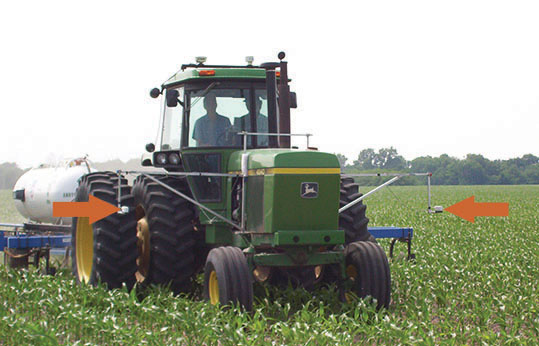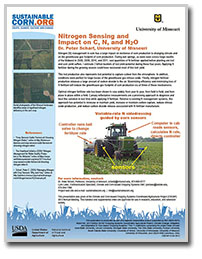Nitrogen Management
 |
The orange arrows point to the N sensors. A computer in the cab reads the sensors, calculates N rate and controls the release of nitrogen fertilizer. Photo courtesy Peter Scharf, Professor, University of Missouri |
Tools for diagnosing an optimal nitrogen (N) application rate have historically been minimally-used in corn production, largely due to inconvenience and limited accuracy. Canopy N-sensors have the potential to reduce the impact of climate change on productivity of agricultural systems by providing a feedback mechanism for adaptive management. This project will examine the use of crop canopy sensors to improve N fertilizer rate decisions and more precisely meet actual crop needs and simultaneously adapt N management to improved carbon (C) management practices. Reasons for N variability are not fully understood, but appear to be primarily differences in how much N the soil supplies.
Nitrogen management can reduce the double footprint of N fertilizer in climate change: the large amount of CO2 released during N fertilizer production, and the nitrous oxide emissions which are released after fertilizer application. We also expect that sensor-based N management will allow adaptation to changes in soil C management.
Nitrogen Management Resources
See resources below and click on the "Resources" tab on the upper navigation bar for more.
| Instructions for collecting end of season cornstalk samples for nitrate testing and interpretation of results. This video is based on cornstalk testing information from Iowa State University Extension, and on the article “Corn Stalk Nitrate Interpretation” by Dr. John Sawyer, Iowa State University. This video was created by Chad Ingels and Charles Wittman, and produced by Charles Wittman. |
| An introduction to woodchip bioreactors and how they can help reduce nitrates in drainage tile water from cropping systems before the water flows into streams and rivers. |
 |
|
| Speed Science: Nitrogen Management | Dr. Peter Scharf, Professor, University of Missouri, discusses the use of nitrogen sensing equipment to maximize efficiency and minimize loss of nitrogen fertilizer, and nitrogen management’s potential to decrease production costs, increase crop yield and reduce greenhouse gas emissions in corn-based cropping systems. This presentation was made at this project's 2012 annual conference. |
